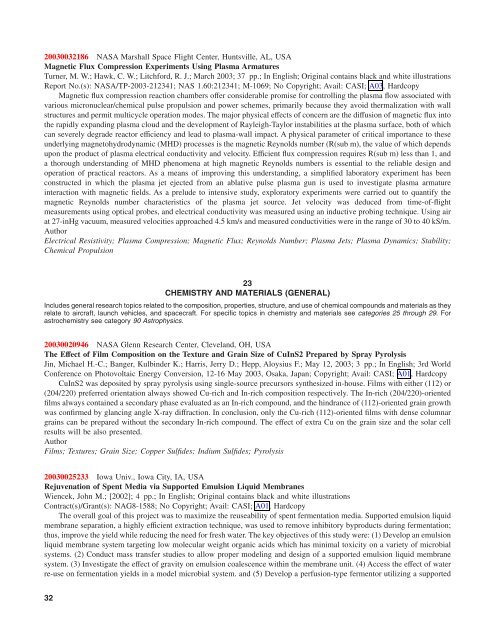You also want an ePaper? Increase the reach of your titles
YUMPU automatically turns print PDFs into web optimized ePapers that Google loves.
20030032186 NASA Marshall Space Flight Center, Huntsville, AL, USA<br />
Magnetic Flux Compression Experiments Using Plasma Armatures<br />
Turner, M. W.; Hawk, C. W.; Litchford, R. J.; March 2003; 37 pp.; In English; Original contains black and white illustrations<br />
Report No.(s): NASA/TP-2003-212341; NAS 1.60:212341; M-1069; No Copyright; Avail: CASI; A03, Hardcopy<br />
Magnetic flux compression reaction chambers offer considerable promise for controlling the plasma flow associated with<br />
various micronuclear/chemical pulse propulsion and power schemes, primarily because they avoid thermalization with wall<br />
structures and permit multicycle operation modes. The major physical effects of concern are the diffusion of magnetic flux into<br />
the rapidly expanding plasma cloud and the development of Rayleigh-Taylor instabilities at the plasma surface, both of which<br />
can severely degrade reactor efficiency and lead to plasma-wall impact. A physical parameter of critical importance to these<br />
underlying magnetohydrodynamic (MHD) processes is the magnetic Reynolds number (R(sub m), the value of which depends<br />
upon the product of plasma electrical conductivity and velocity. Efficient flux compression requires R(sub m) less than 1, and<br />
a thorough understanding of MHD phenomena at high magnetic Reynolds numbers is essential to the reliable design and<br />
operation of practical reactors. As a means of improving this understanding, a simplified laboratory experiment has been<br />
constructed in which the plasma jet ejected from an ablative pulse plasma gun is used to investigate plasma armature<br />
interaction with magnetic fields. As a prelude to intensive study, exploratory experiments were carried out to quantify the<br />
magnetic Reynolds number characteristics of the plasma jet source. Jet velocity was deduced from time-of-flight<br />
measurements using optical probes, and electrical conductivity was measured using an inductive probing technique. Using air<br />
at 27-inHg vacuum, measured velocities approached 4.5 km/s and measured conductivities were in the range of 30 to 40 kS/m.<br />
Author<br />
Electrical Resistivity; Plasma Compression; Magnetic Flux; Reynolds Number; Plasma Jets; Plasma Dynamics; Stability;<br />
Chemical Propulsion<br />
23<br />
CHEMISTRY AND MATERIALS (GENERAL)<br />
Includes general research topics related to the composition, properties, structure, and use of chemical compounds and materials as they<br />
relate to aircraft, launch vehicles, and spacecraft. For specific topics in chemistry and materials see categories 25 through 29. For<br />
astrochemistry see category 90 Astrophysics.<br />
20030020946 NASA Glenn Research Center, Cleveland, OH, USA<br />
The Effect of Film Composition on the Texture and Grain Size of CuInS2 Prepared by Spray Pyrolysis<br />
Jin, Michael H.-C.; Banger, Kulbinder K.; Harris, Jerry D.; Hepp, Aloysius F.; May 12, 2003; 3 pp.; In English; 3rd World<br />
Conference on Photovoltaic Energy Conversion, 12-16 May 2003, Osaka, Japan; Copyright; Avail: CASI; A01, Hardcopy<br />
CuInS2 was deposited by spray pyrolysis using single-source precursors synthesized in-house. Films with either (112) or<br />
(204/220) preferred orientation always showed Cu-rich and In-rich composition respectively. The In-rich (204/220)-oriented<br />
films always contained a secondary phase evaluated as an In-rich compound, and the hindrance of (112)-oriented grain growth<br />
was confirmed by glancing angle X-ray diffraction. In conclusion, only the Cu-rich (112)-oriented films with dense columnar<br />
grains can be prepared without the secondary In-rich compound. The effect of extra Cu on the grain size and the solar cell<br />
results will be also presented.<br />
Author<br />
Films; Textures; Grain Size; Copper Sulfides; Indium Sulfides; Pyrolysis<br />
20030025233 Iowa Univ., Iowa City, IA, USA<br />
Rejuvenation of Spent Media via Supported Emulsion Liquid Membranes<br />
Wiencek, John M.; [2002]; 4 pp.; In English; Original contains black and white illustrations<br />
Contract(s)/Grant(s): NAG8-1588; No Copyright; Avail: CASI; A01, Hardcopy<br />
The overall goal of this project was to maximize the reuseability of spent fermentation media. Supported emulsion liquid<br />
membrane separation, a highly efficient extraction technique, was used to remove inhibitory byproducts during fermentation;<br />
thus, improve the yield while reducing the need for fresh water. The key objectives of this study were: (1) Develop an emulsion<br />
liquid membrane system targeting low molecular weight organic acids which has minimal toxicity on a variety of microbial<br />
systems. (2) Conduct mass transfer studies to allow proper modeling and design of a supported emulsion liquid membrane<br />
system. (3) Investigate the effect of gravity on emulsion coalescence within the membrane unit. (4) Access the effect of water<br />
re-use on fermentation yields in a model microbial system. and (5) Develop a perfusion-type fermentor utilizing a supported<br />
32
















